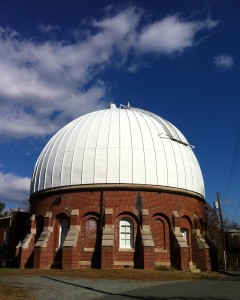
Leander McCormick Observatory, Mount Jefferson, University of Virginia, November 2013. Image credit: JR
I took the students in my “Spaces of Science” seminar to the Leander McCormick Observatory at University of Virginia for a viewing session last night. Sometimes I forget how fun it is to watch students learn—it often happens outside class, when they’re reading and writing and making connections across courses. So, to be under the same dome with them during the process was really lovely experience.
Much of last night’s success was due to McCormick’s outreach program. I could have listened to Dr. Ed Murphy talk for another three hours. He imparted a lot of information, ranging from a discussion of the serrated blades of the McCormick reaper (really) to the reason Betelgeuse appears red to the naked eye, but managed to wrap it all into an entertaining narrative that held our attention. I swear, even I believed Orion could stand in the ocean before he took an arrow to the head.
I freely admit that some of the pleasure of last night came from the fact that I also got to look through the 26-inch telescope. That’s the largest refractor I’ve ever used, and I enjoyed it so much I almost asked if I could stay late to watch Ganymede emerge from Jupiter’s shadow. As it was, we had a great view of Jupiter and Io during the class session. Dr. Murphy also showed them the Trapezium Cluster in the Orion nebula and blew one of my student’s mind when he told her that “new born” means 3,000,000 years old when it comes to stars.
Approximately half my students under-dressed for the weather, which was bad in that the temperatures fell below freezing, but good in that the class experienced observational astronomy as it would have been in the nineteenth century. One of the things that students can’t learn about the (historical) practice of astronomy unless they visit a big instrument is how much observing depends on bodily motion. We’ve been reading about Lick Observatory, where the floor moved up and down on a system of hydraulics to help astronomers chase objects across the sky. At McCormick, the approach was more traditional—astronomers climbed up and down a laddered observer’s chair that moves around the observatory on wheels. Then there was the manual positioning of the telescope as well as dome rotation (dome rotation still done by hand at McCormick). And then there was observing in the freezing cold, because heating the dome would disturb the optics with warm air currents.
I hope my students had as much fun as I had. Check back in a couple months for an update—I’m applying for a ticket to visit University of Virginia’s Fan Mountain Observatory in April. I hope that my students caught the bug and will join me for the evening.